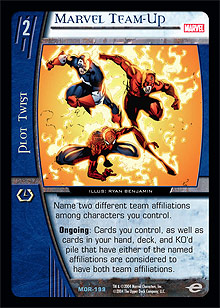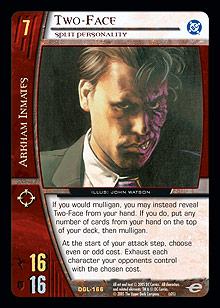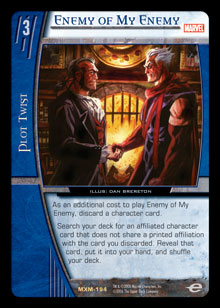By now, everyone’s gotten his or her first taste of Marvel Team-Up from this weekend’s Sneak Preview, and soon enough players everywhere will be knee-deep in Constructed and gorging themselves on as many drafts as they can justify. For this anxious in-between time, the Marvel Team-Up design articles are here to escort you comfortably to your destination, beginning today and continuing along until you decide you’ve had enough or the next Sneak Previews begin (whichever comes first). In the interest of maintaining the American spirit of continual escalation, today’s design article features not one, not two, but three authors. We three writers will be rotating in and out of the series in somewhat arbitrary fashion—hopefully the others will replace me more often than I them, as my writing tends toward insulting more than informative (especially when Ben Seck is around). But in earnest, and speaking exclusively of my peers, both Billy and Patrick were instrumental in the design and success of Marvel Team-Up in more ways than can be formally documented. The others will speak for themselves today, but a short introduction is certainly in order:
 The Actors
The Actors
Andrew Yip
As the creator of such epic duels as the Fantastic Four and X-men vs. Brotherhood starter decks, I was once again plucked from the ever-increasing pool of qualified candidates to co-lead design Marvel Team-Up. In addition to my startlingly simple design philosophies and contrasting tendency to use more words than necessary (in person and in writing. Hah!), my initial design vision for Marvel Team-Up was a set that would reflect fondly on past Marvel sets.
Patrick Sullivan
Patrick Sullivan was my fellow lead designer for Marvel Team-Up. His penchant for “nuts and bolts” deck construction and his keen development instincts quickly found him a unique responsibility in addition to his lead design: to moderate my designs and Billy’s, thus preventing lead developer Dave Humpherys from KO’ing both of us outright upon seeing the first design file. Such throwback home runs as the The Enforcers can be attributed to Patrick’s love for classic Spider-Man comics.
Billy Zonos
Also known as “The Flavor Police,” Billy was responsible for making sure that we were designing for the comic characters and not just arbitrarily assigning powers to names. The number of times when a character’s name would be literally interpreted onto his power would be uncountable if not for Billy pulling the designer aside and detailing the various Bad Things that would happen if Spider-Man could attack eight characters at once. (Fortunately, we are a little bit more familiar with comics than that . . . most of the time.)
Prologue
Andrew:
As always, my memories of the earliest conversations about Marvel Team-Up are vague at best. I’ll do my best to report them here, and Pat and Billy will do the same. Much will be repeated for sure, but the most interesting parts are the differences in each account. Fresh off completing design for Heralds of Galactus, I was very much in designer mode when my eyes first glanced in the direction of Marvel Team-Up. Beyond knowing that Spider-Man needed to make a huge impact, I wasn’t sure of much else. These abstractions would quickly fill in once the initial team roster of the Spider-Friends, Marvel Defenders, Sinister Syndicate, and Underworld were chosen. With three teams returning from Marvel Knights and Web of Spider-Man, and two logical pairings of villain and hero teams, the imaginary Marvel Team-Up set quickly congealed in my mind as something reminiscent of both sets, with a very obvious delineation between teams. From a flavor perspective, it’s obvious that Spider-Man spent many of his days fighting the Syndicate, and that flavor needed to carry through to the cards themselves. At the same time, with clean delineation comes the desire to blur the lines—after all, some of the most exciting cards ever designed are the ones that break the rules. That’s where the Marvel Knights set and its dual team-stamped cards came in . . .
 Patrick:
Patrick:
For years, my primary work on Vs. has been development, which I’ve been doing in some capacity since Marvel Knights. I have, however, dropped a few design hits in my day. I can still clearly recall the first time a card I had designed (Two-Face, Split Personality) made it to print, back in Green Lantern Corps. Although I still consider it an important stepping stone to where I am today, in retrospect it has all the hallmark traits of amateur card design. For starters, it’s really powerful, as every first-time designer tries to create the new “best” version of whatever is being created. Secondly, I tried really hard to literally interpret the power of the character in the comics. I guess a better way of doing that would be to flip a coin and randomly generate an odd or even result, but that would have added even more text to an essay of a card. This leads us nicely into my last critique of the card: it has a billion lines of text and two completely unrelated abilities, making it a bit of a headache to read and understand. Now, Two-Face is still obviously the bomb, and I know it’s a pretty popular card to a large part of our player base. Even as I criticize the card, I believe that you can make a Two-Face (in terms of complexity and text and so on) every so often. But make a set of Two-Faces, or even a team of them, and the game quickly becomes unbearable. Now, my responsibility is to churn out fewer Two-Faces and more “nuts and bolts” cards with which to fill out an entire team.
Yip and I went offsite to discuss our early ideas for the teams, the overall design cohesion of the set, and our general impression of the state of the game. While not all of our ideas for the teams lasted to the end (or even to the end of that afternoon), the philosophy of the overall design remained largely intact.
1) Teams need to matter, and teaming-up needs to matter.
 Be it because of Enemy of My Enemy, a constantly expanding card pool, player innovation, a lack of team-stamping on certain powerful cards, or any combination of the above, teams haven’t meant as much in Vs. System as they did during the game’s infancy. One need only look at decks from our first Pro Circuit (all either mono-team or actual team-up decks, barring Apocalypse or an out of place Wolverine, Berserker Rage) and compare them to the modern toolbox decks for it to become obvious that team affiliation matters less in Vs. system than it did back then. We both felt that team affiliation needed to again matter, and that we needed to encourage it through stricter team stamping, rewards for mono-team deck construction, and punishment of players who strayed away from that. Of course, playing multiple-team decks is fine as long as teaming-up is involved, so that needed to be encouraged as well. Above all, we wanted to return (or try to return) to an era where players would describe their decks as “Common Enemy” or “The New Brotherhood” rather than “Stall with ten teams, no team-ups, and no team-stamped cards.” Of course, some amount of bleed or non-team-stamping is okay, but we really wanted that to be the exception rather than the norm of deck construction.
Be it because of Enemy of My Enemy, a constantly expanding card pool, player innovation, a lack of team-stamping on certain powerful cards, or any combination of the above, teams haven’t meant as much in Vs. System as they did during the game’s infancy. One need only look at decks from our first Pro Circuit (all either mono-team or actual team-up decks, barring Apocalypse or an out of place Wolverine, Berserker Rage) and compare them to the modern toolbox decks for it to become obvious that team affiliation matters less in Vs. system than it did back then. We both felt that team affiliation needed to again matter, and that we needed to encourage it through stricter team stamping, rewards for mono-team deck construction, and punishment of players who strayed away from that. Of course, playing multiple-team decks is fine as long as teaming-up is involved, so that needed to be encouraged as well. Above all, we wanted to return (or try to return) to an era where players would describe their decks as “Common Enemy” or “The New Brotherhood” rather than “Stall with ten teams, no team-ups, and no team-stamped cards.” Of course, some amount of bleed or non-team-stamping is okay, but we really wanted that to be the exception rather than the norm of deck construction.
2) The re-features need to play well with their original cards.
Spider-Friends, Sinister Syndicate, and Underworld were all slated to return, and we wanted to make sure that the new cards made sense with the old ones. That meant some evasion and defensive tricks for Spider-Friends, aggression and KO effects for Syndicate, and concealed characters and KO’d pile manipulation for Underworld. Of course, we would try to take them in a new direction or add a twist to the old themes, but we wanted them to remain honest to the original feature. We figured that the players who are nostalgic for these teams wanted them to feel like the teams they remembered, and we wanted the old cards to play well with the new ones.
With our initial concepts ready to go, I spent some time scribbling down ideas for Syndicate . . .
Billy:
A few things before I begin:
- I’m not going to try to compete with Mr. Yip or Mr. Sullivan in the comedic department. These gentlemen destroy me. Every time.
- I will do my best to tell it like it actually happened, without exaggeration or fabrication. Unadulterated truth shall seep from my fingers into your eyes.
I would like to point out that as I write this, I only have the vaguest of introductions from Mr. Yip to work with. I’m sure that in the end his keen editorial eye (and his disdain for the obvious “Get it?” joke) will be enough to ensure a cohesive three-way flow. I would also like to point out to those who think it’s all Fun and Games how strenuous my job truly is. Last time, I had only the Yip to deal with. By himself, he is small and quite manageable. This time, however, with the addition of Patrick “Baby Face” Sullivan, I was a bit overwhelmed by the pair’s perpetual buffoonery. Put yourself in my shoes and imagine how problematic it must be trying to have a serious conversation about the “flavor correctness” of characters like Howard the Duck, Man-Thing, or Razorfist with these jokers. It’s no wonder I welcome the breaks between sets.
Thankfully, Sullivan’s aversion to instant messaging limited my interactions with him to the basketball court . . . where I obviously schooled his behind. I don’t care if you are “East Coast”—this is how we put it down in Cali, my friend. But seriously, I love Sullivan like a brother. The man’s childish enthusiasm for the Sinister Syndicate knows no limit, and as Yip stated above, you can thank him for the Enforcers’ cardboard debut. (But you can thank me for limiting said debut to a single plot twist. You’re welcome.)
As is our custom when commencing work on a new set, Andrew came up from Carlsbad to lay down the foundations for Marvel Team-Up over fruity smoothies at Juice It Up.
Billy: “Let’s do Defenders.”
Andrew: “Underworld re-feature.”
Billy: “Defenders!”
Andrew: “Underworld!”
Right then, Andrew’s phone rang. It was Patrick, so he put it on speakerphone.
Patrick: “Sinister Syndicate!”
Andrew flipped it closed.
Andrew: “Vampires!”
So yeah, that’s basically (give or take some exclamation points) how it began . . .
’Til Next Time
With the stage set, the new three kings of Vs. pressed forward into creating the initial design file. Boundless hurdles were encountered and overcome in the first weeks, but those epic encounters will be detailed in subsequent articles. In the coming weeks, Patrick, Billy, and I will go through each team and present our collective memories of their design and development from start to finish. Next week, our eyes turn to the main man himself, Spider-Man (and the Spider-Friends)!